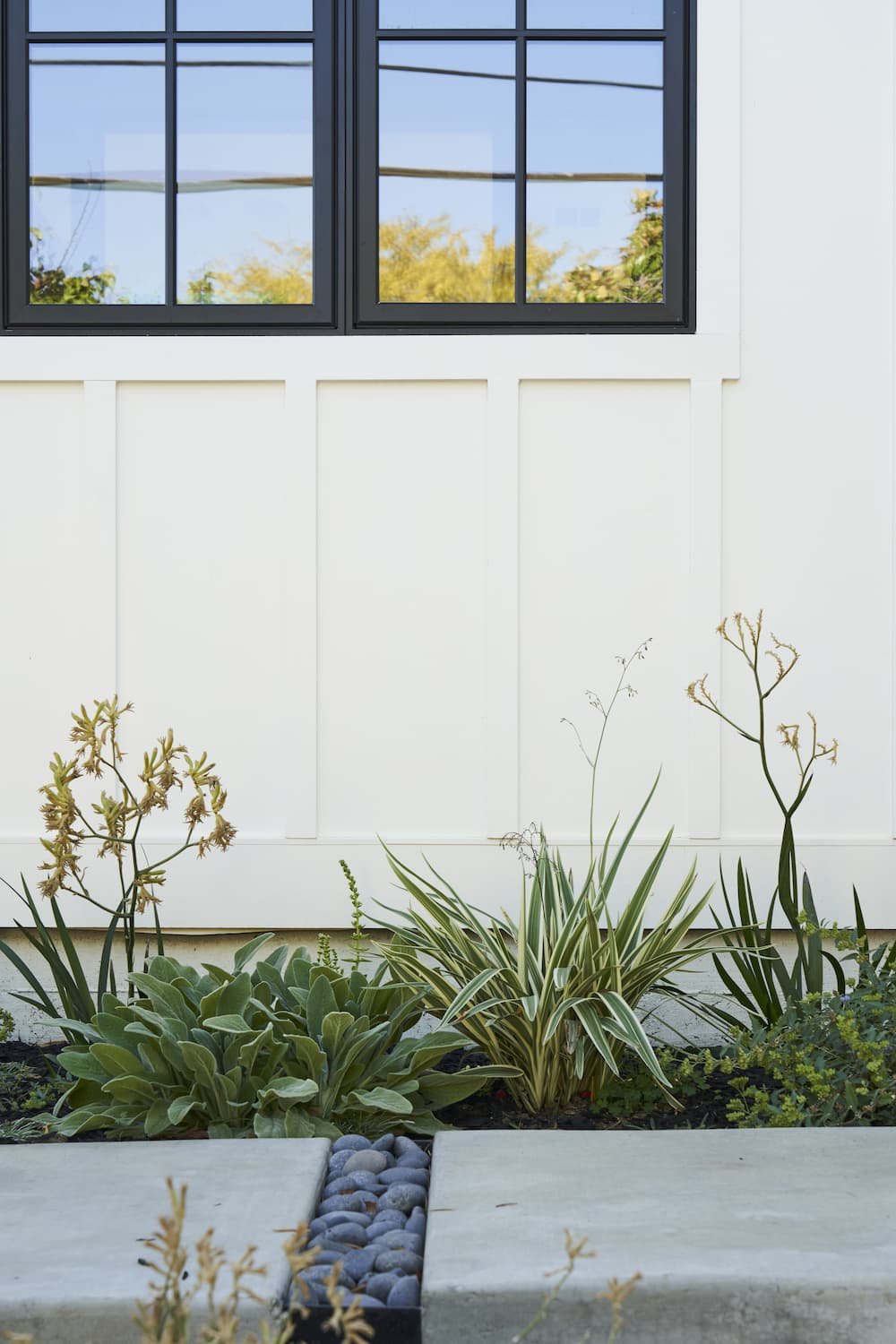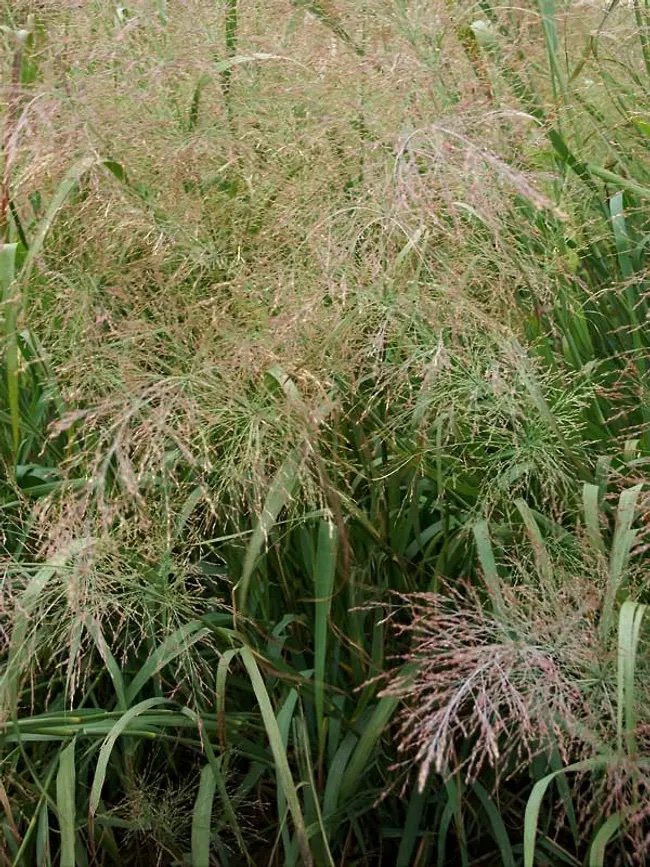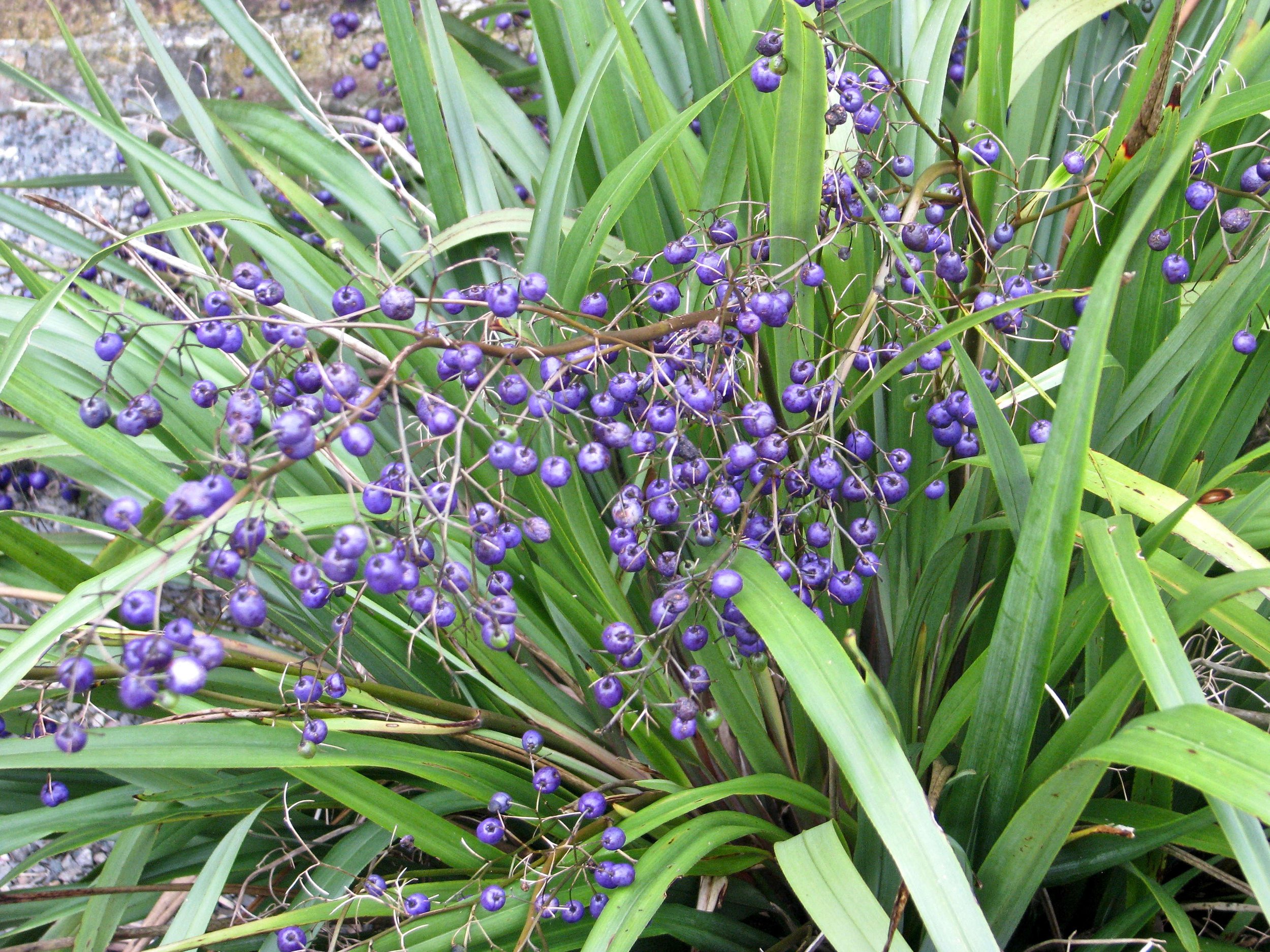Ornamental grasses are an undisputed favorite among landscape designers and homeowners alike. We get why: feathery texture, charismatic motion in the breeze, and, frequently, great tolerance of drought conditions.
Ornamental grass Variegated Flax Lily (Dianella tasmanica ‘Variegata’) flanked by Kangaroo Paws (Anigozanthos) in a front yard designed by Yardzen in Los Gatos, CA
Not all grasses are the same, though—from species to species, you’ll discover a broad range of colors, textures, heights, and habits. Look hard enough, and you’ll find a grass to meet any landscape need.
Let’s take a look now at some of the most popular ornamental grass (or grass-like) species. Afterward, we‘ll share some tips to help you start and maintain ornamental grasses in your own landscape designs.
Pink Muhly Grass / Muhlenbergia capillaris
Image courtesy of monrovia.com
Who can argue with a native grass that glows pink in the Fall? Pink Muhly (also called Gulf Muhly) is drought tolerant, though it doesn‘t mind some extra water. An early spring cut-back is standard practice to keep it looking sharp, otherwise, it’s reputed for its low maintenance requirements. Plant alone (in the ground or a container), or for a visual wallop, arrange it in a vivid, rosy row.
Prairie Dropseed / Sporobolus heterolepis
Image courtesy of prairienursery.com
Tough, long-lived, and gorgeous, Prairie Dropseed is a habitat-rich native plant in addition to being a proven landscape winner. It tolerates drought and a variety of soil types, and requires little maintenance once established. Plant it in masses, mixing in prairie perennials like coneflowers or asters for a meadow look. Added perk: its blooms smell like popcorn!
Feather Reed Grass / Calamagrostis ‘Karl Foerster’
Image courtesy of monrovia.com
One of the most popular ornamental grasses out there, the tall, slender ‘Karl Foerster’ solves many a design challenge, from vertical accenting to providing privacy. This award-winning species is a hit all over, but is particularly popular in the Mountain West. Pop it in sunny, dry locations, as a monolithic row or as a backdrop to meadow flowers.
Blue Fescue / Festuca glauca
Image courtesy of monrovia.com
This little, silvery-blue grass is a low-water hit for low masses or edging. Drawbacks? It‘s relatively short-lived, and can tend to look scraggly after a while. Cutting it back and dividing every few years can help to mitigate these issues.
Lomandra
Image courtesy of sunsetwesterngardencollection.com
Lomandra ’Breeze’ and ’Platinum Beauty’ are each evergreen grass-like perennials, extremely popular throughout both California and the Southeast. They have attractive, strappy foliage, grass-green for ‘Breeze‘ and white variegated for ‘Platinum Beauty‘. They tolerate drought and coastal salt, and can handle a bit of shade as well as full sun. For folks in California, once you know this plant, you’ll see it everywhere.
Little Bluestem / Schizachyrium scoparium
Image courtesy of whiteflowerfarm.com
We love this plant, which along with Big Bluestem, Switchgrass, and Indian Grass, is native to tallgrass prairies of the Central United States. Little Bluestem is coveted for its upright habit and its color, which goes from blue-green to a showy auburn-red in the Fall. Good for sunny, fairly dry locations. Birds love it, deer do not.
Big Bluestem / Andropogon gerardii
Image courtesy of prairienursery.com
This native tall grass can reach 6’, and is a great option for a feathery privacy screen or a tall backdrop in a meadowy planting design. Like Little Bluestem, Big Bluestem puts on a color show, proceeding from blue-green, to green, to a rusty red in the Fall. It needs some water to get started, but once established, it performs well in dry conditions.
Berkeley Sedge / Carex divulsa
Image courtesy of greenmeadowgrowers.com
Technically not a grass, this low, mounding evergreen sedge makes for a lush, undulating blanket of green when planted in groups. It likes medium water, but will tolerate a little drought once established. It‘s best in part shade, but gets by decently in brighter or darker conditions.
Maiden Grass / Miscanthus sinensis
Image courtesy of gardenia.net
Maiden Grass is big, capable of reaching up to 9’ tall and 6’ wide. Native to Asia, it prefers moist soil, and grows easily—so easily, in fact that some consider it to be mildly invasive. Be that as it may, it’s quite popular, particularly the ‘Morning Light‘ cultivar. Use it in the ground or containers. Added perk: it’s great as a dried ornamental in floral displays.
Deergrass / Muhlenbergia rigens
Image courtesy of davesgarden.com
This West Coast native grass is super adaptable, and happy with virtually no water. Its bright green color bleaches out in the Fall, and makes for attractive winter interest. The foliage is alert and upright at first, relaxing into a delicate, arching habit later in the year. Delicate flower spikes shoot up above the bulk of the grass, reaching to 5’.
Purple Fountain Grass / Pennisetum setaceum ‘Rubrum’
Image courtesy of johnson-nursery.com
Purple Fountain Grass is perennial in warmer climates, but worth growing as an annual in cooler places on account of its great color and texture. It’s a reliable "thriller" in container plantings, and is both drought tolerant and deer resistant. One warning: do not plant the straight species Pennisetum setaceum—it is invasive in many areas. For a smaller, greener alternative, try Pennisetum alopecuroides ‘Little Bunny’.
Japanese Forest Grass / Hakonechloa ’Aureola’
Image courtesy of waltersgardens.com
This immensely popular ornamental grass has a graceful, mounding habit and show-stopping foliage. The variegated leaves are shiny and striped in chartreuse and grassy green. It dies back in winter, but not before a showy display of warm Fall color. It likes part shade, and needs a good bit of water. Cut it back to the ground in late winter or early spring.
Switchgrass / Panicum virgatum
Image courtesy of bluestoneperennials.com
A powerhouse native grass found across large swaths of the US, Switchgrass is tall enough to help with privacy, or to use as a delicate vertical accent. Being tall, it sways readily in a breeze. Switchgrass features wispy seed heads in late Summer and Fall, and glowing color in the Fall. It and does well in dry or wet conditions, and prefers sun or a bit of shade.
Mexican Feather Grass / Stipa tenuissima
Image courtesy of monrovia.com
This stunning species is a bit notorious. Native to the mountains of West Texas and Southern New Mexico, Mexican Feather Grass it reseeds prolifically, and is invasive outside of its native range. We‘ve seen healthy, mature specimens growing through pavement cracks. Its beauty persuades many to plant it anyway, but we advise avoiding it outside of its native range.
Pampas grass / Cortaderia selloana
Image courtesy of gardenia.net
Another tricky one, Pampas Grass is gorgeous but invasive. A very tall grass - commonly 8‘ in height, maxing out around 12‘—with robust vertical plumes, it has the makings of a fabulous accent or privacy plant, and many use it for just those purposes (we advise against doing so). The dwarf ‘Pumila’ cultivar is sterile (and therefore not invasive), making for a more ecologically responsible option. It still reaches as high as 5’, too, plenty tall to help screen views or emphasize a scene.
Mondo grass / Ophiopogon japonicus
Image courtesy of monrovia.com
This Asian-native is low and dark, and widely used as a mounding, spreading groundcover. It resists herbivory from deer and other critters, and grows densely enough to outcompete pretty much any weeds. The regular species grows up to 1’ in height, while the dwarf ‘Nana’ cultivar tops out at 6”.
New Zealand Flax / Phormium
Image courtesy of gardenista.com
Thick, pointed blades make the evergreen New Zealand Flax a ready-made accent in a variety of planting styles. Its many cultivars range in color: chartreuse (‘Yellow Wave‘), black cherry (‘Purpureum‘), magenta (‘Evening Glow’), orange (‘Apricot Queen’), and beyond. Many Phormiums get big, exceeding 4’ or even 5’ in height. Recommended for individual specimen planting, though we’ve seen rows used as a rather bulky privacy screen.
Inland Sea oats / Chasmanthium latifolium
Image courtesy of nativebackyards.com
Native to Eastern North America, this unique grass has oat-like drooping flowers and bamboo-like leaves. It spreads quickly, and should be planted en masse. Cut back in late winter, otherwise this popular species is an easy one to take care of. Good for activating shady spots.
Flax Lily / Dianella
Image courtesy of gardenista.com
There are several cultivars of this Australian grass look-alike, which has risen to popularity for for its arching, strappy leaves and minimal maintenance requirements. ’Variegata’ has white stripes on it, and is a superb accent plant in lower light settings. ‘Little Rev’ has that prized pale blue color, and can handle a bit more sun. Same goes for ‘Cassa Blue‘, which boasts good drought tolerance to boot. The variegated or darker green options, including ’Tasred’, are great for setting a tropical vibe.
Blue Grama / Bouteloua gracilis
Image courtesy of thepollennation.com
This all-star native dominated America’s shortgrass prairies. Short grass indeed: Blue Grama tops out at 14“. It’s tough as nails, withstanding cold, heat, and drought. It’s also beautiful, forming pillowy tufts of true grass-green foliage, with delicate blonde seedheads hovering above that look either like the accent above a Spanish vowel. It’s commonly included in sod blends, and is a solid option for a habitat-rich, low-water lawn replacement.
California Grey Rush / Juncus patens
Image courtesy of gardenia.net
This versatile California native is another winner to convey a tropical look on a low water budget. It’s also a solid option for dry shade conditions, though it can also handle full sun (will need a bit more water). Its unique texture—fine, upright, stiff, reedy—makes it a go-to textural accent within West Coast planting designs.
Blue Oat Grass / Helictotrichon sempervirens
Courtesy of mckaynursery.com
Dry soils intensify the pale blue color of this easy-to-grow Mediterranean grass. A great low-water option across much of the US, Blue Oat Grass is a particular favorite in the Mountain states of Colorado and Utah. It looks great in just about any aesthetic, including as a softening accent in rock gardens or desert garden designs. Common practice calls for cutting it back near winter’s end.
Lilyturf / Liriope muscari
Image courtesy of prairieblossomnursery.com
Also called Monkey Grass, Liriope is a grass look-alike (it‘s from the asparagus family) that is particularly popular as a groundcover but also prized for edging, containers, and slope stabilization. Summer brings blooms, typically lavender, but most of the year Liriope is notable for its luscious, low foliage. It’s tough and easy to grow, tolerating heat, humidity, and a bit of drought. That said, it prefers moderate water and part shade, and is not suitable for foot traffic. ‘Silvery Sunproof’ is a hit for its variegated foliage and tolerance of extra sunlight.
Tufted Hairgrass / Deschampsia cespitosa
Image courtesy of prairienursery.com
Native to broad stretches of North America, this showy species has a mounding habit with a cloud of fine-textued, hair-like flowers floating above. It starts green and transitions to gold, and sticks around for reliable winter interest. Tufted Hairgrass is good for shady spots, and requires fairly moist soil. It’s also an important habitat plant for several butterfly species.
Cape Rush / Chondropetalum tectorum
Image courtesy of gardenista.com
Cape Rush can handle wet or dry conditions, and looks downright fancy in a nice pot. We love it as a reliable fine-textured accent that, like Juncus, has an upright, rigid manner that makes it particularly striking. Large Cape Rush (C. elephantinum) will get you the same perks plus additional height. Try Cape Rush when you want an Asian or tropical look on a lower water budget.
TIPS FOR GARDENING WITH ORNAMENTAL GRASSES
Cool-season vs. Warm-season.
Cool-season grasses grow in the spring before it gets hot, and usually maintain their color throughout the warm summer months.
Cool-season species include: Feather Reed Grass (Calamagrostis ‘Karl Foerster’), Tufted Hairgrass (Deschampsia cespitosa), Blue Fescue (Festuca glauca), Blue Oat Grass (Helictotrichon sempervirens).
Warm-season grasses grow later, starting in late spring or early summer once the weather is warmer. They tend to go tan or brown once weather turns cold.
Warm-season species include: Little Bluestem (Shizachyrium scoparium), Switchgrass (Panicum virgatum), Japanese Forest Grass (Hakonechloa), Maiden Grass (Miscanthus), Mondo Grass (Ophiopogon).
Plant Grasses in Spring or Early Fall
Planting in Spring gives grasses a chance to establish themselves before the heat kicks in. Planting in Fall does the same with respect to winter’s cold. Avoid planting in the summer, when excess irrigation would be necessary to keep fledgling grasses alive.
Cut Grasses Back Appropriately
Cool-season grasses should be cut back in early Spring to one-third of their height (careful not to cut them too short). Warm-season grasses can be cut back all the way to the ground once their foliage goes brown, starting in the Fall.
Cutting back can improve fire safety and make for a tidier appearance, but there are also great reasons to leave warm-season grasses uncut through the winter. For one, they often make for lovely winter interest, particularly in snowy areas. The old foliage also helps to insulate the crown and roots, and provides nesting habitat for native bees and other beneficial insects.
Divide Smaller Grasses to Spread them Across the Garden
You can do this with simple hand tools, digging them up, gently dividing them by hand, and replanting them before the roots dry out. For larger grasses, the principles are the same, but the work can be tough, requiring saws or other tools to unearth and divide the plants.
Skip the Fertilizer
Most ornamental grasses don’t need any nutrient supplements beyond organic mulch like shredded leaves. They may actually respond poorly when over-fertilized.
Be Fire-Smart
Many ornamental grass species are quick to burn, particularly if their foliage is dried-out. In fire prone areas, cut back annually to keep foliage hydrated and healthy, clear out dead plant matter, and keep ornamental and other plants that are prone to burning away from structures and out from under trees where they could create fire ladders. Learn more about fire-smart landscaping from Cal Fire.
GET STARTED WITH YOUR LANDSCAPE DESIGN BY YARDZEN
Yardzen's award-winning online exterior and landscape design is tailored to clients in all fifty states in the US. Whether your goal is creating more functional outdoor living space or beautifying your home exterior, we can create a design that meets your needs and style preferences.
Our design process begins with understanding your space, your aesthetic preferences, and a discussion of your budget and vision to minimize surprises when it comes time to build.
Our top-notch designers then develop a personalized vision for your yard, shared through 3D renderings, 2D plan drawings, and plant and material lists. Your design will capture the look, feel, and function you are hoping for, all while keeping costs within range.
Once your design is complete, we'll help you connect with a local contractor from our Pro Network of vetted professional landscapers to install your new design.
Ready to live better outside? Create your design profile or explore our design packages today!


























